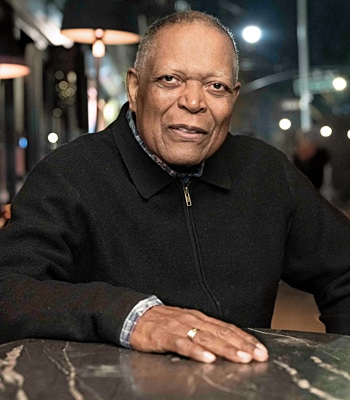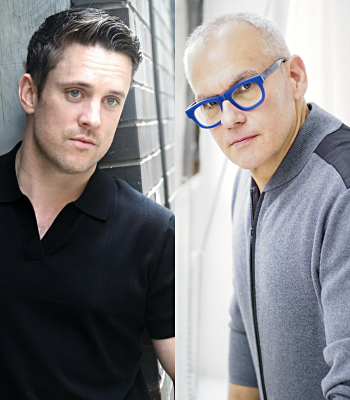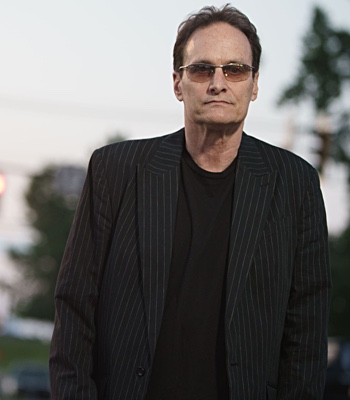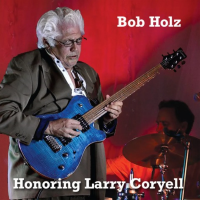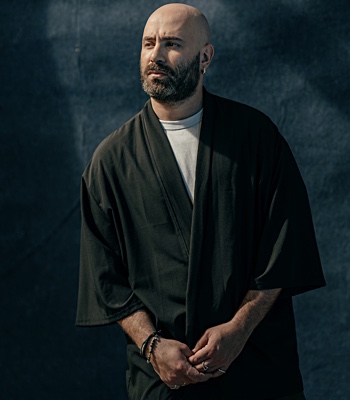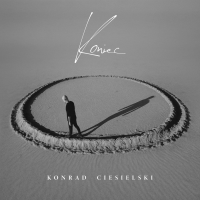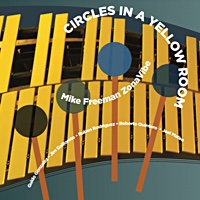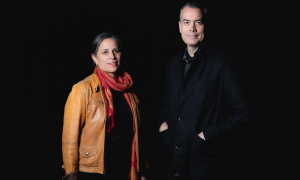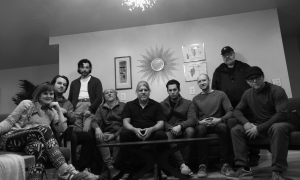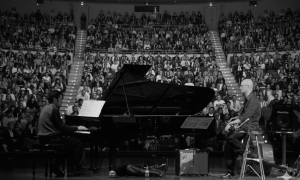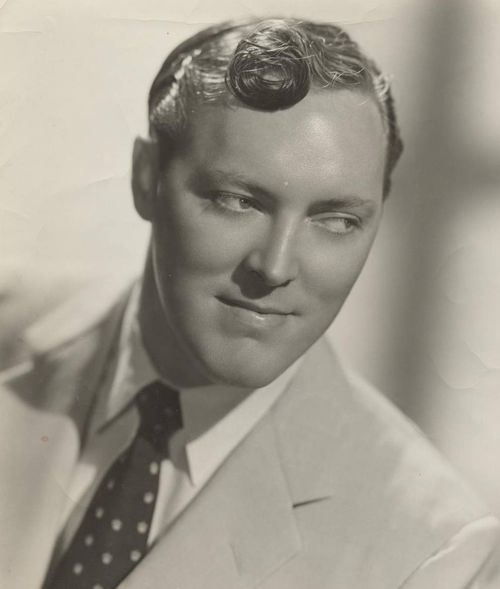
Sixty years ago today, Bill Haley's Rock Around the Clock hit #1 on all three of Billboard's pop charts at the time. It was the first time an R&B song accomplished that feat, and it signaled the birth of rock 'n' roll. Not the music, the attitude. As I write in today's Wall Street Journal (go here), rock in the decades that followed the record's release would be inextricably linked with teenage rebellion against parents and authority figures. But the move to insurgency wasn't the music industry's idea. It was a fluke that began with a Hollywood brainstorm.
R&B had been on the rise since the mid-1940s, when whimsical songs about the social quirks of everyday life met the backbeat—an emphasis on the second and fourth beats. Louis Jordan (above), Lionel Hampton, Illinois Jacquet and dozens of other jump blues instrumentalists and blues shouters were capitalizing on a dance form that by 1949 was so commercially powerful that Billboard renamed its “Race Records" chart “Rhythm & Blues Records."
R&B continued to widen its teenage appeal in the early 1950s as the number of independent radio stations grew and the unbreakable vinyl 45 began to replace the 78 in stores and jukeboxes. Concerts and teen TV shows followed, fueled by hyperactive disc jockeys and payola.
When Bill Haley and His Comets' Rock Around the Clock was first released in May 1954, the single reached only #23 on Billboard's pop chart before disappearing. Haley's voice sounded more country than city, which undercut the song's credibility. Then something strange happened. The song turned up a year later playing during the opening and closing credits of Blackboard Jungle, a grim film about the worrisome menace of juvenile delinquency in urban public schools. Teens were portrayed as aimless, nihilistic thugs. Except teens didn't see the film that way.
Blackboard Jungle was released in March 1955, and for many teens, the movie wasn't about a teacher trying to get control of his bad-seed students. Instead, they saw the film as a reflection of their own feelings, a lost generation trying to make sense of their world and being misunderstood at every turn by adults who lectured them and disparaged their values. Instead of being scared by the film, young audiences saw it as payback.
Once the visual of bored, rebellious teens in Blackboard Jungle was united with Rock Around the Clock, R&B crossed over to the white mass market, and the song went to #1 in July 1955. When that happened, radio needed a race-neutral name for music that increasingly featured white rockabilly artists from the South. Disc jockeys came up with “rock and roll," a term that appeared on a record by the Boswell Sisters as far back as 1934...
So, the difference between R&B and rock 'n' roll isn't musical or racial. The two forms are actually the same, and plenty of black artists in the 1950s like Bo Diddley, Little Richard and Chuck Berry were part of rock 'n' roll revues. The difference between the two is rock's promotion of teen recalcitrance against parental control, something it has done remarkably well for generations to keep the music viable.
By the way, jazz played a big role in Blackboard Jungle. Early on, teacher Richard Dadier (Glenn Ford) bonds with Josh Edwards (Richard Kiley), a nerdy teacher who has been ground down by the futility of trying to save emotionally damaged students. As the film unfolds, we learn that Edwards loves his jazz record collection. When Dadier and Edwards catch a drink at a bar after school one afternoon, Stan Kenton's recording of Bill Holman's Invention for Trumpet and Guitar is playing on the jukebox. Edwards is so enthralled with the music of “Stan the Man," Maynard Ferguson's trumpet and Sal Salvador's guitar that he insists he's going to play his jazz records in class to engage his students.
Dadier, a pragmatist, tries to discourage Edwards, who stubbornly insists the experiment will work because “it took me 15 years to collect those records." Later, when Edwards plays Bix Beiderbecke's The Jazz Me Blues in class, the students, led by miscreant Artie West (Vic Morrow), destroy his collection.
In that one scene, teens were taught that jazz was the music of detached, condescending adults—an unfortunate and ignorant lesson that rock musicians are still trying to undo today.
Oh, one more thing: the producer of Bill Haley's Rock Around the Clock? Milt Gabler.
JazzWax clips: Here's Rock Around the Clock from the movie's opening credits, with the extended drum solo added...
Here's the movie trailer for Blackboard Jungle...
Here's Bill Holman's Invention for Trumpet and Guitar by the Stan Kenton Orchestra...
And here's Bix Beiderbecke's The Jazz Me Blues...
R&B had been on the rise since the mid-1940s, when whimsical songs about the social quirks of everyday life met the backbeat—an emphasis on the second and fourth beats. Louis Jordan (above), Lionel Hampton, Illinois Jacquet and dozens of other jump blues instrumentalists and blues shouters were capitalizing on a dance form that by 1949 was so commercially powerful that Billboard renamed its “Race Records" chart “Rhythm & Blues Records."
R&B continued to widen its teenage appeal in the early 1950s as the number of independent radio stations grew and the unbreakable vinyl 45 began to replace the 78 in stores and jukeboxes. Concerts and teen TV shows followed, fueled by hyperactive disc jockeys and payola.
When Bill Haley and His Comets' Rock Around the Clock was first released in May 1954, the single reached only #23 on Billboard's pop chart before disappearing. Haley's voice sounded more country than city, which undercut the song's credibility. Then something strange happened. The song turned up a year later playing during the opening and closing credits of Blackboard Jungle, a grim film about the worrisome menace of juvenile delinquency in urban public schools. Teens were portrayed as aimless, nihilistic thugs. Except teens didn't see the film that way.
Blackboard Jungle was released in March 1955, and for many teens, the movie wasn't about a teacher trying to get control of his bad-seed students. Instead, they saw the film as a reflection of their own feelings, a lost generation trying to make sense of their world and being misunderstood at every turn by adults who lectured them and disparaged their values. Instead of being scared by the film, young audiences saw it as payback.
Once the visual of bored, rebellious teens in Blackboard Jungle was united with Rock Around the Clock, R&B crossed over to the white mass market, and the song went to #1 in July 1955. When that happened, radio needed a race-neutral name for music that increasingly featured white rockabilly artists from the South. Disc jockeys came up with “rock and roll," a term that appeared on a record by the Boswell Sisters as far back as 1934...
So, the difference between R&B and rock 'n' roll isn't musical or racial. The two forms are actually the same, and plenty of black artists in the 1950s like Bo Diddley, Little Richard and Chuck Berry were part of rock 'n' roll revues. The difference between the two is rock's promotion of teen recalcitrance against parental control, something it has done remarkably well for generations to keep the music viable.
By the way, jazz played a big role in Blackboard Jungle. Early on, teacher Richard Dadier (Glenn Ford) bonds with Josh Edwards (Richard Kiley), a nerdy teacher who has been ground down by the futility of trying to save emotionally damaged students. As the film unfolds, we learn that Edwards loves his jazz record collection. When Dadier and Edwards catch a drink at a bar after school one afternoon, Stan Kenton's recording of Bill Holman's Invention for Trumpet and Guitar is playing on the jukebox. Edwards is so enthralled with the music of “Stan the Man," Maynard Ferguson's trumpet and Sal Salvador's guitar that he insists he's going to play his jazz records in class to engage his students.
Dadier, a pragmatist, tries to discourage Edwards, who stubbornly insists the experiment will work because “it took me 15 years to collect those records." Later, when Edwards plays Bix Beiderbecke's The Jazz Me Blues in class, the students, led by miscreant Artie West (Vic Morrow), destroy his collection.
In that one scene, teens were taught that jazz was the music of detached, condescending adults—an unfortunate and ignorant lesson that rock musicians are still trying to undo today.
Oh, one more thing: the producer of Bill Haley's Rock Around the Clock? Milt Gabler.
JazzWax clips: Here's Rock Around the Clock from the movie's opening credits, with the extended drum solo added...
Here's the movie trailer for Blackboard Jungle...
Here's Bill Holman's Invention for Trumpet and Guitar by the Stan Kenton Orchestra...
And here's Bix Beiderbecke's The Jazz Me Blues...
This story appears courtesy of JazzWax by Marc Myers.
Copyright © 2025. All rights reserved.


